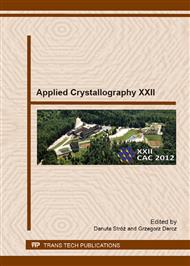p.77
p.81
p.86
p.90
p.94
p.101
p.105
p.111
p.115
Microstructural Evolution and Corrosion Behavior of Carburized α-Fe Plates by Glucose
Abstract:
The aim of this paper is to obtain an experimental characterization of glucose-carburized substrates of α-Fe. The carburization process was achieved under vacuum condition using glucose as a carburizing medium. The process was carried out at several temperatures keeping the duration constant at 2h. The samples were treated at 400°C, 650°C and 900°C. The microstructure of the as produced coatings was observed by Scanning Electron Microscopy (SEM) and the formed phases were analyzed by X-Ray Diffraction (XRD). To investigate the corrosion properties of the carburized iron specimens, electrochemical tests were conducted. The samples were exposed to a solution of 3.5% wt. NaCl electrolyte, under quiescent conditions at room temperature and open to the air. The corroded samples were observed with use of Optical Microscopy in order to evaluate the corrosion effect on their surfaces. Carburization of iron samples at temperatures up to 650°C resulted in a shift of the polarization curves to lower current densities. Smaller corrosion rates were measured indicating higher corrosion resistance for these specimens.
Info:
Periodical:
Pages:
94-98
Citation:
Online since:
June 2013
Keywords:
Price:
Сopyright:
© 2013 Trans Tech Publications Ltd. All Rights Reserved
Share:
Citation:


